国际货物贸易交易磋商教案
贸易磋商公开课教案
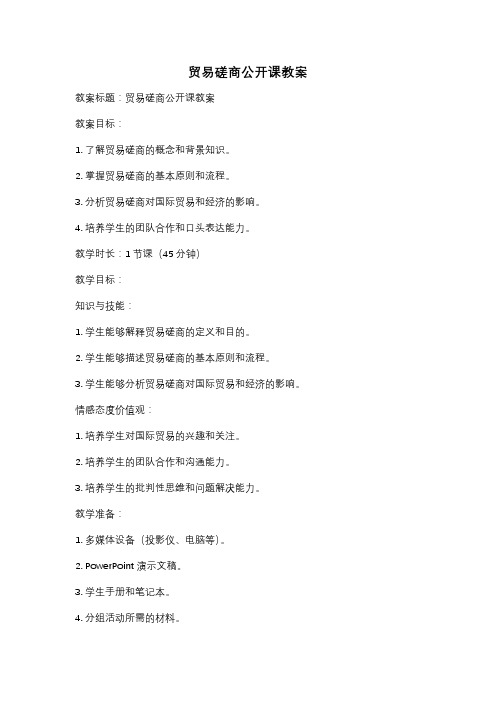
贸易磋商公开课教案教案标题:贸易磋商公开课教案教案目标:1. 了解贸易磋商的概念和背景知识。
2. 掌握贸易磋商的基本原则和流程。
3. 分析贸易磋商对国际贸易和经济的影响。
4. 培养学生的团队合作和口头表达能力。
教学时长:1节课(45分钟)教学目标:知识与技能:1. 学生能够解释贸易磋商的定义和目的。
2. 学生能够描述贸易磋商的基本原则和流程。
3. 学生能够分析贸易磋商对国际贸易和经济的影响。
情感态度价值观:1. 培养学生对国际贸易的兴趣和关注。
2. 培养学生的团队合作和沟通能力。
3. 培养学生的批判性思维和问题解决能力。
教学准备:1. 多媒体设备(投影仪、电脑等)。
2. PowerPoint演示文稿。
3. 学生手册和笔记本。
4. 分组活动所需的材料。
教学步骤:步骤一:导入(5分钟)通过展示一张世界地图,引导学生思考不同国家之间的贸易关系,并提出以下问题:- 你知道贸易磋商是什么吗?- 为什么国家之间需要进行贸易磋商?步骤二:知识讲解(15分钟)使用PowerPoint演示文稿,向学生介绍贸易磋商的定义、目的和基本原则。
重点讲解以下内容:- 贸易磋商的定义和目的。
- 贸易磋商的基本原则,如最惠国待遇、关税减让等。
- 贸易磋商的流程,包括谈判、协商和签署协议等。
步骤三:案例分析(15分钟)将学生分成小组,每个小组选择一个贸易磋商案例进行分析。
案例可以是近年来发生的国际贸易争端或自由贸易协定谈判。
要求学生回答以下问题:- 这个案例中的贸易磋商目的是什么?- 贸易磋商的基本原则在这个案例中得到了体现吗?- 这个案例中的贸易磋商对国际贸易和经济有什么影响?步骤四:小组展示与讨论(10分钟)每个小组派一名代表向全班展示他们的案例分析结果,并与其他小组进行讨论和交流。
教师可以提供指导性问题,促进学生的思考和讨论。
步骤五:总结与提问(5分钟)教师对本节课的内容进行总结,并提出一些问题,鼓励学生思考和提问。
例如:- 贸易磋商在国际贸易中起到了什么作用?- 你认为贸易磋商对发展中国家有何影响?教学延伸:1. 鼓励学生自主研究和了解更多的贸易磋商案例。
国际贸易实务-教案-7.1交易磋商
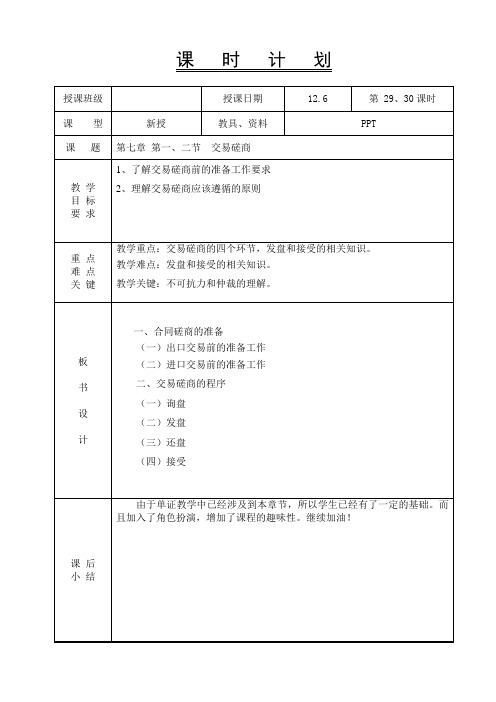
②受盘人有理由信赖该发盘是不可撤销的,并本着对该发盘的信任采取了行动。
一项发盘是否可以撤销,主要取决于受盘人是否可能因为撤销发盘而受到损害。
7.发盘的终止
(1)发盘的终止指发盘法律效力的消失。
(2)发盘的终止具有两方面含义:
发盘人不再受发盘的约束(不受约束);
买方发盘:购货发盘、递盘(bid),买方向卖方提出的发盘
3.构成发盘的条件
[讲解]
(1)表明定约意旨:发盘人必须在发盘中明确表示该发盘一经被接受后就承受约束的意旨。这是发盘的本质特征。即承担与受盘人按发盘条件订立合同的责任。
(2)向一个或一个以上特定的人提出。“特定的人”指在发盘中指明个人姓名或企业名称的受盘人。
接受一经生效,合同即告成立,如要撤销接受,在实质上属毁约行为。
【布置作业】
使用配套习题集《进出口贸易实务学习指导与练习》(第二版),要求学生完成第七章第一、二节的相关习题。
小组抽号完成
可以补充
[分组讨论]
学生分组讨论出口交易前的准备工作。
[分组讨论]
学生分组讨论进口交易前的准备工作。
[分组讨论]
学生分组讨论在发生争议时应尽量选择什么样的解决方式?
5.发盘的撤回
发盘的撤回:实质是阻止发盘生效,指发盘人将尚未被受盘人收到的发盘予以取消的行为。
一般采取比发盘更快的传递方式来发出撤回通知,方可能保证发盘被撤回。用电话、电传进行的发盘不存在撤回的可能性。
6.发盘的撤销
发盘的撤销指发盘人将已经被受盘人收到的发盘予以取消的行为。
《公约》规定:
如果撤销的通知在受盘人发出接受通知之前送达受盘人,可予撤销。但是以下两种情况不得撤销:
《国际贸易实务》教案——第八章 进出口贸易合同的磋商与签订
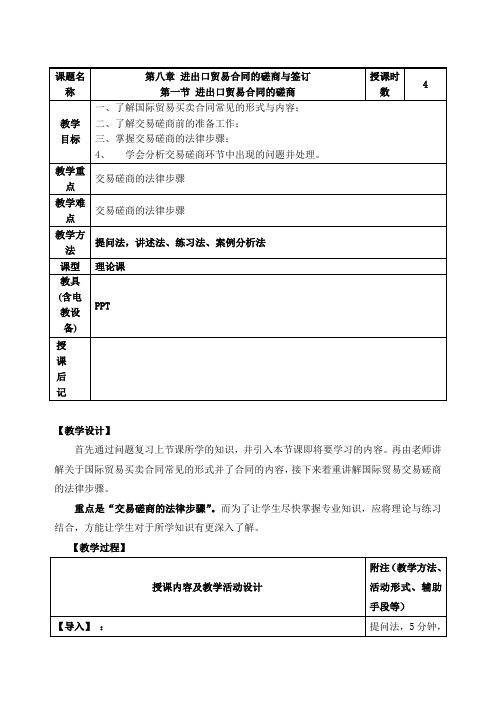
授课内容及教学活动设计
附注(教学方法、活动形式、辅助手段等)
【导入】 :
【问题】 :上一节我们学习了国际贸易中的不可抗力因素以及纠纷的解决,回忆一下,如何认定不可抗力?
【明确】1)意外事故是在合同签订之后发生的;
2)不是由于任何一方当事人的过失或疏忽造成的;
3)意外事件是当事人不能预见和预防,又无法避免和克服的。
【案例分析2】某年六月,甲国某公司准备向国际招标机构投标,由于缺少货源,向我某外贸公司发来求购意向,我公司遂于6月25日向其发实盘并规定有效期至同年7月20日。对方为争取得标,6月30日向我公司发来传真,要求降价20%,我公司于7月2日回电拒绝。对方7月12日给我公司来电,同意接受我方6月25日发盘。此时我公司已将该批货物以高价转卖他国,无法向对方供货,对方遂派专人前来交涉,要求我方供货。问:我方应否向对方供货?
一、《公约》的规定
二、还盘的法律意义
三、注意问题
【案例分析1】中国C公司于2001年7月16日收到巴黎D公司发盘:“马口铁500公吨,每吨545美元CFR中国口岸,8月份装运,即期信用证支付,限20日复到有效”。我方于17日复电:“若单价为500美元CFR中国口岸可接受500公吨马口铁,履约中如有争议在中国仲裁”。D公司复电“市场坚挺,价格不能减,仲裁条件可接受,速复。”此时马口铁价格确实趋涨。我方于19日复电“接受你16日发盘,信用证已由中国银行开出,请确认”。但法商未确认并退回信用证。问:(1)合同是否成立(2)我方有无失误
自学法,讲述法,5分钟,让学生了解合同的相关知识。
随堂小结,讲述法,5分钟。
1. 选配素质较高的洽谈人员
2. 选择较理想的目标市场
3. 选择适当的交易对象
项目5国际贸易的磋商
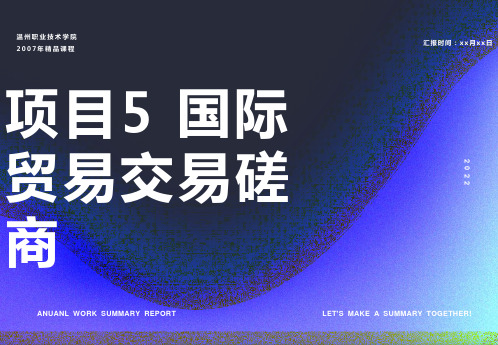
向一个或一个以上的特定人提出
发盘的内容必须十分确定
不指定受盘人的发盘,仅应视为发盘的邀请。
《公约》规定:品名、数量、价格 我国外贸实践:品名和品质、数量、包装、价格、交货和支付条件
2、构成发盘的必要条件
如:发盘、实盘、递实盘或订货等。 若发盘中附有保留条件,如:“以我方最后确认为准”,或“有权先售”等,则此建议只能视为邀请发盘
项目5 国际贸易交易磋商
2022
Anuanl Work Summary Report
Let's make a summary together!
【教学目的】
通过本章的教学,使学生掌握一般交易磋商的主要环节。
【教学重难点】
交易磋商的主要环节:发盘和接受
【教学内容】
交易磋商形式与内容 交易磋商的程序
条件一:接受必须是由受盘人作出
2、构成有效接受的条件
03
条件三:接受的内容要与发盘的内容相符
பைடு நூலகம்02
用口头或书面的声明形式表示接受;还可以用行为表示接受(我国持保留态度)
01
条件二:接受必须表示出来
04
接受应是无条件的
受盘人在表示接受时,不能对发盘的内容作丝毫的变更,这样理解对吗?
非实质性变更是否有效取决于发盘人是否反对
5、发盘的撤销(发盘生效后)
根据《公约》的规定,发盘撤销的条件:发盘人撤销的通知必须在受盘人发出接受通知之前传达到受盘人
不得撤销的发盘:规定有效期或者受盘人有理由信赖该发盘是不得撤销的,且采取了行动。
案例分析
我公司于8月3日以电报方式请法国一供应商出售一批钢材。我方在电报中声明:此发盘是为了计算一项承建一幢大楼的标价和确定是否参加投标之用;我方将于8月15日向招标人送交投标书,而开标日期为8月31日。法商于8月5日用电传就上述钢材向我方发盘,发盘条件虽完成,但既没规定接受期限,也没有注明是否是不可撤销的。我方获悉后,据此计算标价,并于8月15日向招标人递交了投标书。8月20日国际市场钢材价格上涨,法商发来传真通知撤销其8月5日的发盘。我方当即复电表示不同意撤盘。于是双方为能否撤销发盘发生争执。到8月31日招标人开标,我方中标,随即传真法商接受5日的发盘。但法商坚持发盘已于8月20日撤销,合同不能成立。双方就此发生纠纷。
国际贸易课件~国际货物买卖合同的磋商与订立
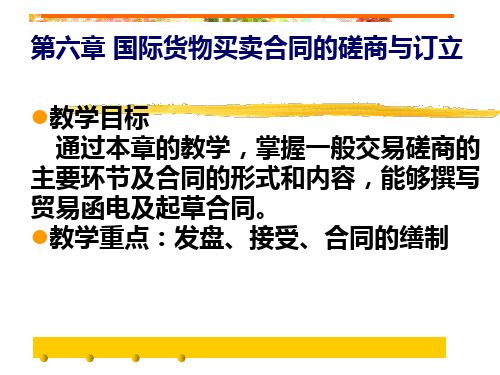
(四)接受(Acceptance) (重点掌握)
1.含义 受盘人接到对方的发盘或还盘后,以声明或行动向
对方表示同意发盘条件的行为。 2、性质:
订立合同的必经环节 对发盘一旦表示接受,合同关系即告成立。
3、构成条件: (1)必须是由特定的受盘人做出 案例:香港某A商,就某商品以电传形式邀请 我方发盘,我方于6月8日向A方发盘并限6月15 日复到有效。12日我方收到美国B商人按我方 发盘规定的各项交易条件开来的信用证,同时 收到香港某A商的来电称:“你8日的发盘已转 美国B商”。经查该商品的国际市场价格猛涨, 于是我方将信用证退回开证银行,再按新价向 美国B商发盘,而美国B商以信用证于发盘有效 期内到达为由,拒绝接受新价,并要求我方按 原价发货,否则将追究我方的责任。问:美国 B商的要求是否合理?为什么?
7、发盘的失效 当受盘人不接受发盘提出的条件 受盘人作出还盘 发盘人依法撤销发盘 发盘中规定的有效期届满 人力不可抗拒的意外事故造成发盘的失效,如政 府禁令或限制措施 在发盘被接受前,当事人丧失行为能力、或死亡 或法人破产等。
(三)还盘(Counter-Offer) 1、含义:受盘人不同意或者不完全同意发盘人在
5、发盘的生效时间 (1)口头发盘:其法律效力自对方了解发 盘内容时生效 (2)书面发盘: 发信主义:发盘人将发盘发出的同时,发 盘就生效。 受信主义:发盘必须送达受盘人时生效 。 《公约》、我国《合同法》以及大部分国 家的法律都认为发盘必须送达受盘人才生 效
发盘的生效时间 关系到受盘人能否表示接受 关系到发盘人何时可以撤回发盘或修改其 内容
案例:我某进出口公司向国外某商人询购
某商品,不久,我方收到对方8月15日的 发盘,发盘有效期至8月22日。我方于8月 20日向对方复电:“若价格能降至56美元 /件,我方可以接受”。对方未作答复。8 月21日我方得知国际市场行情有变,于当 日又向对方去电表示完全接受对方8月15 日的发盘。问:我方的接受能否使合同成 立?为什么?
《国际贸易实务》课程教案2-交易磋商的形式和内容、订立国际货物买卖合同的法律步骤
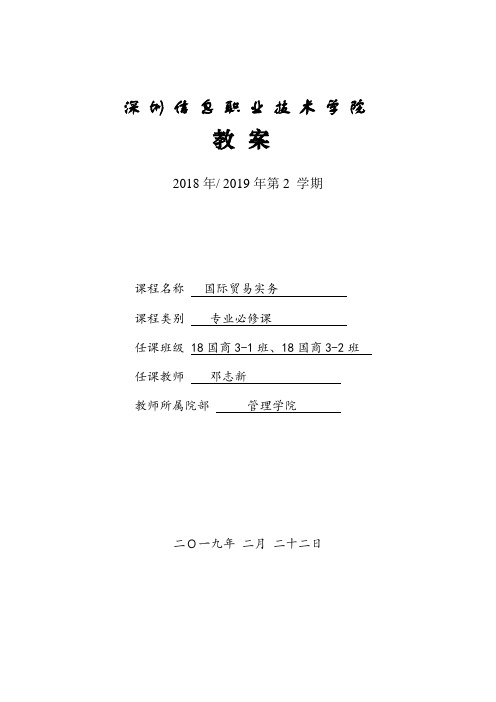
A、发盘的撤回(wቤተ መጻሕፍቲ ባይዱthdrawal)
B、发盘的撤消(revocation)
(4)发盘效力的终止(termination)
任何一项发盘,其效力均可在一定条件下终止。其终止的原因,一般有以下几个方面:
A、过期,指发盘在规定的有效期内未被接受,或虽未规定有效期,但在合理时间内未被接受,则发盘的效力即告终止。
深圳信息职业技术学院
教案
2018年/2019年第2学期
课程名称国际贸易实务
课程类别专业必修课
任课班级18国商3-1班、18国商3-2班
任课教师邓志新
教师所属院部管理学院
二O一九年二月二十二日
学科
国际贸易实务
课题
交易磋商的形式和内容、订立国际货物买卖合同的法律步骤
周次
时数
授课班级
教学目的及要求:
1、通过本章的教学,使学生了解交易磋商谈判的原则。
一、询盘(inquiry)
(1)买方询盘,也称“邀请发盘”(invitation to offer)
(2)卖方询盘,也称“邀请递盘”(invitation to bid)
二、发盘(offer)
发盘又称发价或报价(quotation),在法律上称为要约。
(1)发盘应具备的条件:
A、发盘应向一个或一个以上特定的人(specific persons)提出。
B、发盘内容必须十分确定(sufficient definite)
C、必须表明发盘人对其发盘一旦被接受即受约束的意思
D、发盘必须送达受盘人
(2)发盘的有效期(validity of offer)
发盘都是有有效期的,其表现形式有:
A、明确规定发盘的有效期
《国际贸易实务》电子教案(2) 项目十
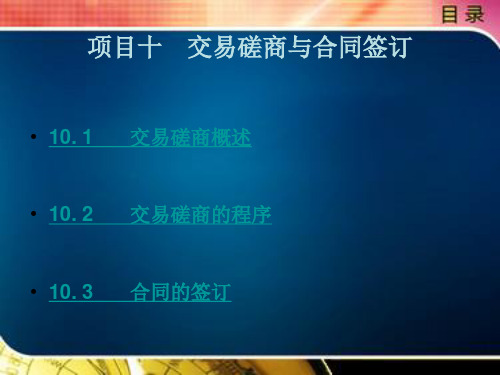
下一页 返回
10. 1 交易磋商概述
• 1. 电话磋商 • 通过电话进行磋商时, 因国际长途电话花费昂贵, 所以应该事先写好通
话提纲, 掌握通话时间, 做好通话记录和录音; 同时应选择好通话时间, 考虑世界各地的时差因素, 应选择对方适当的时间进行通话。为达成 交易, 接着要去信确认, 谈话记录归入客户档案或业务档案以备查考。 • 2. 洽谈会 • 如通过洽谈会当面洽谈达成交易, 则首先要制订谈判方案, 内容包括谈 判日期、时间、地点、对象、我方主谈人员、谈判内容、目的和要求 等。谈判时要认真做好谈判记录。谈判结束, 达成交易, 双方可在整理 的谈判记录上签字确认, 原始的谈判记录归入客户档案或业务档案以 备查考。
上一页 下一页 回
10. 1 交易磋商概述
• 二、交易磋商的内容
• 交易磋商的内容, 涉及拟签订的买卖合同的各项条款, 其中包括品名、 品质、数量、包装、价格、装运、保险、支付以及商检、索赔、仲裁 和不可抗力等。从理论上讲, 只有就以上条款逐一达成一致意见, 才能 充分体现“契约自由” 的原则。然而, 在实际业务中, 并非每次洽商 都需要把这些条款一一列出、逐条商讨。这是因为, 在普通的商品交 易中, 一般都使用固定格式的合同, 而上述条款中的商检、索赔、仲裁、 不可抗力等通常作为一般交易条件印就在合同中, 只要对方没有异议, 就不必逐条重新协商, 这些条件也就成为双方进行交易的基础。在许 多老客户之间, 事先已就“一般交易条件” 达成协议, 或者双方在长 期的交易过程中已经形成一些习惯做法, 或者双方已订有长期的贸易 协议。在这些情况下, 也不需要在每笔交易中一一重新协商各项条款。 这对于缩短洽商时间和节约费用开支都是有益的。
第三章国际货物买卖合同的磋商与订立教案案例分析和习题(含答案)国际贸易实务(第三版)课件

第三章国际货物买卖合同的磋商与订立教案案例分析和习题(含答案)国际贸易实务(第三版)课件第三章国际货物买卖合同的磋商与订立【教学要求】国际货物买卖在国际贸易中占有极为重要的地位,国际贸易最基本和最原始的形式就是国与国之间的商品交换。
通过本章的学习,认识国际货物买卖合同的特点和内容,了解合同磋商的复杂性和法律性,掌握国际货物买卖合同成立的必要条件,在理解有关法律规则的基础上,逐步提高签订合同的技巧和水平。
【主要内容】1、国际货物买卖合同是指营业地处于不同国家的当事人所订立的货物买卖合同。
货物买卖合同是指卖方为了取得货款而把货物的所有权移交给买方的一种双务合同,其的特点有国际性、货物性和买卖性。
订立国际货物买卖合同应遵循的原则包括平等原则、自愿原则、公平原则、诚实信用原则、合法和尊重社会公德的原则。
2、交易磋商是指买卖双方以买卖某种商品为目的而通过一定程序就交易的各项条件进行洽商并最后达成协议的全过程。
交易磋商在形式上可分为口头和书面两种。
交易的一般程序应包括邀请发盘、发盘、还盘、接受和签订合同等环节,其中发盘和接受是交易成立的基本环节,也是合同成立的必要条件。
根据《公约》的规定,一项发盘必须具备三个条件:向一个或一个以上的特定人提出;表明订立合同的意思;发盘的内容须十分确定。
根据《公约》的解释,构成有效的接受要具备的条件是:接受必须是由受盘人做出;受盘人表示接受,要采取声明的方式;接受的内容要与发盘的内容相符;接受的通知要在发盘的有效期内送达发盘人才能生效。
3、国际货物买卖合同成立应具备的条件:有当事人必须在自愿和真实的基础上达成协议,买卖双方当事人应具有法律行为的资格和能力,合同必须以双方互惠、有偿为原则,合同的标的和内容必须合法,合同的形式必须符合法律规定的要求。
4、在国际贸易业务中,书面合同主要采用销售合同、销售确认书两种。
书面合同的内容一般由下列三部分组成:约首、本文和约尾。
其中本文是合同的主体部分,国际货物买卖合同的主要条款如下:合同各方、标的物条款、价格条款、交货条款、支付条款、商检条款、不可抗力与免责、合同争议的解决方式。
国际货物贸易交易磋商教案
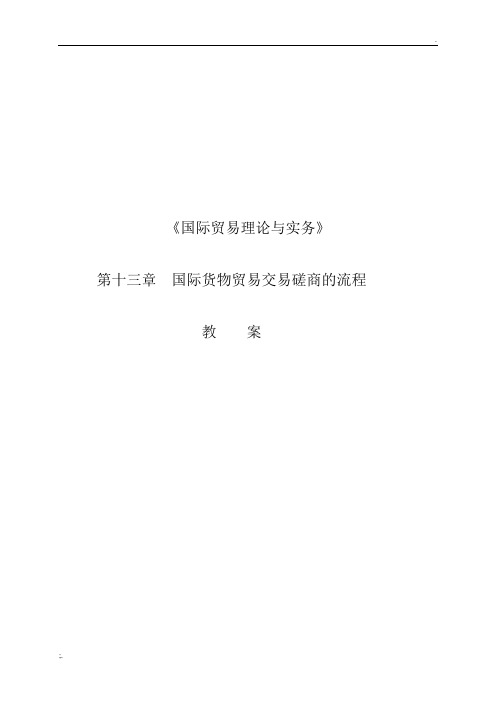
.《国际贸易理论与实务》第十三章国际货物贸易交易磋商的流程教案二、案例教学边做边教(30分钟)理论授课为主,模拟演练为辅一、询盘(Inquiry)(10分钟)1、理解含义:又称询价、问价,法律上称为“要约邀请”,指交易的一方欲购买或出售某种商品,向另一方发出探询买卖该商品及有关交易条件的一种表示。
2、询盘示例:例1:对贵公司的长毛绒玩具感兴趣,请报价。
例2:对贵公司的长毛绒玩具感兴趣,请报价。
CIF大阪8月装运,速复。
3、模拟演练:进口方业务员分别向出口方业务员模拟演练交易磋商中的询盘环节进口方(1)日本高田商社出口方(1) 南京进出口贸易公司(2)上海进出口贸易公司(3)大连进出口贸易公司三个公司经营的主要产品均为玩具、服装等轻工业产品,销往日本、欧美等国际市场,出口商品和服务质量在国际上有一定的声誉。
日本高田商社分别向三家公司询盘:小组探究1:业务员在询盘时,需要列明什么内容?结论:学生们通过观察,分析、归纳,总结得出询盘时,除列明所需商品外,还可以列明商品价格、所需的数量、所要求的交货期,甚至列出将来合同的主要内容。
小组探究2:中国民间有话说:“货比三家不吃亏”,那么对外询盘是不是越多越好呢?师生共同分析得出结论:询盘的策略4、询盘术语及典型句式:Please advise/ quote/ offer…Interested in … please…(1)Do you offer FOB or CIF?(2)How long does your offer remain valid/firm/open?(3) Please make us an offer within this month since wehave made an inquiry for your products(4)Please send us your best offer by Internet stating payment terms and time of shipment.(5)Full information as to prices, quality, quantity available and other relative particulars would be appreciated.师生共同探索理论联系实际学生小组探索补充知识.二、案例教学边做边教案例巩固2:(生效与撤回)A在2月17日用航空信寄出一分注有“不可撤销”字样的实盘给B,规定受盘人在2月25日前答复有效。
国际贸易实务教案项目二 交易磋商环节

四、接受
(一)接受的含义
(二)构成有效接受的条件
(三)有条件的接受
【总结】
【任务分配】
回顾上次课的任务提出新的任务,激发学生学习兴趣
明确本节课的主要目标
通过案例,让学生对掌握交易磋商工作
分配任务,通过实际操作,掌握操作技能
任务导向教学法:通过布置任务,激发学生的求知欲
讲授法
案例教学法
实践教学法:通过完成任务,掌握操作技能
对本教案
修改意见
需增加的资源
其它
教研室主任:
系主任:
教案
教学步骤与内容
教学目标
教学方法
学习情境一交易前准备
【导入任务】
模块三交易磋商
项目二交易磋商环节
【任务导向】
一、询盘
二、发盘
三、还盘
四、接受
【课程讲授】
一、询盘
二、发盘
(一)发盘的含义
(二)构成有效发盘的必要条件
(Байду номын сангаас)发盘的有效期
(四)构成发盘失效的情况
教案首页
课程名称:《国际贸易实务》2
教学对象
授课日期
教学内容
模块三交易磋商
项目二交易磋商环节
计划学时
2
教
学
目
的
知识
1.了解磋商含义;
2.掌握磋商内容。
技能
1.能够熟练完成磋商;
2.能够处理磋商过程中出现的问题。
态度
1学科意识;
2认真态度。
教学重点难点
交易磋商程序
交易磋商过程中出现问题的处理
教学资源
教材、PPT课件、网络资源
教学环节安排
1.复习导入新课(3mins)
《交易磋商的程序》教学设计

巩固练习,课堂总结
PPT展示
教师总结,并展示巩固练习题
学生:分组进行抢答
通过总结与练习,让学生更好的掌握知识点
模块四
课后延伸、综合应用
情景模拟
PPT展示模拟交易磋商的案例
教师将学生分为两组分别扮演进口商和出口商,根据PPT案例模拟交易磋商。
学生根据分组,安排及准备模拟内容
让学生积极的参入到课堂中
2.评价量表内容(测试题、作业描述等)
一、简答
1、构成发盘的要件有哪些?
2、按照《公约》的规定,发盘在什么情况下撤回和撤销?
3、发盘效力在哪些情况下终止?
4、分析逾期接受的效力?
5、合同成立的要件有哪些?
二、填空题
1、在国际货物买卖合同商定的过程中,一般包括:( )、( )、( )、( )四个环节,其中( )和( )是达成交易,合同订立的不可或缺的两个基本环节。
情景模拟
小组情景展示
教师观看小组的模拟交易,最后针对学生模拟中出现的问题进行点评
学生:对模拟实践表现出浓厚的兴趣。
在这个环节中,把课堂交给学生鼓励学生积极参与到模拟实践中,让学生有参加课堂的体验感
五、评价方案设计
1.评价形式与工具(A、B、D)可多选
A.课堂提问 B.书面练习 C.制作作品 D.测验 E.其他
学生:回答老师的问题,学习构成发盘的4个要件
学习构成发盘的条件
案例:
小王的麻烦!
PPT展示
展示PPT中小王的发盘,让学生去修改发盘
帮助案例中的小王,找出发盘中不正确的内容并修改
巩固掌握构成发盘的4个条件
案例:
小王又有麻烦啦!
PPT展示
针对案例继续提问小王:发盘后第二天,查单发现衬衫数量不足,想要取消发盘内容,他该怎么做?能做到吗?
国际贸易实务——第八章 交易磋商和合同订立
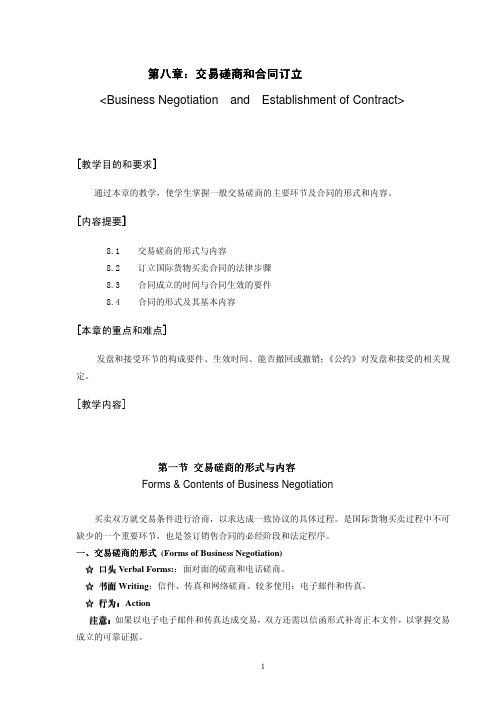
第八章第八章::交易磋商和合同订立<Business Negotiation and Establishment of Contract>[教学目的和要求]]通过本章的教学,使学生掌握一般交易磋商的主要环节及合同的形式和内容。
[内容提要]]8.1 交易磋商的形式与内容8.2 订立国际货物买卖合同的法律步骤8.3 合同成立的时间与合同生效的要件8.4 合同的形式及其基本内容[本章的重点和难点]]发盘和接受环节的构成要件、生效时间、能否撤回或撤销;《公约》对发盘和接受的相关规定。
[教学内容]第一节 交易磋商的形式与内容Forms & Contents of Business Negotiation买卖双方就交易条件进行洽商,以求达成一致协议的具体过程。
是国际货物买卖过程中不可缺少的一个重要环节,也是签订销售合同的必经阶段和法定程序。
一、交易磋商的形式 (Forms of Business Negotiation)☆口头Verbal Forms::面对面的磋商和电话磋商。
☆书面Writing :信件、传真和网络磋商。
较多使用:电子邮件和传真。
☆行为行为::Action注意注意::如果以电子电子邮件和传真达成交易,双方还需以信函形式补寄正本文件,以掌握交易成立的可靠证据。
二、交易磋商的内容Contents of Business Negotiation1。
主要交易条件Major Trade Terms and Conditions包括货物的品质、数量、包装、价格、交货和支付条件等内容(六项条件是买卖合同不可缺少的交易条件,双方必须经过磋商并取得一致)2.一般交易条件General Trade Terms and Conditions一般交易条件指交易双方拟订的对每笔交易都适用的一套共性的交易条件,通常包括:(1)有关预防和处理争议的条件(商品的检验、索赔、不可抗力和仲裁)(2) 有关主要交易条件的补充说明(数量的溢短装条款、品质机动幅度条款等); (3) 个别主要交易条件(支付条款、保险条款等)。
第十章-国际贸易交易磋商
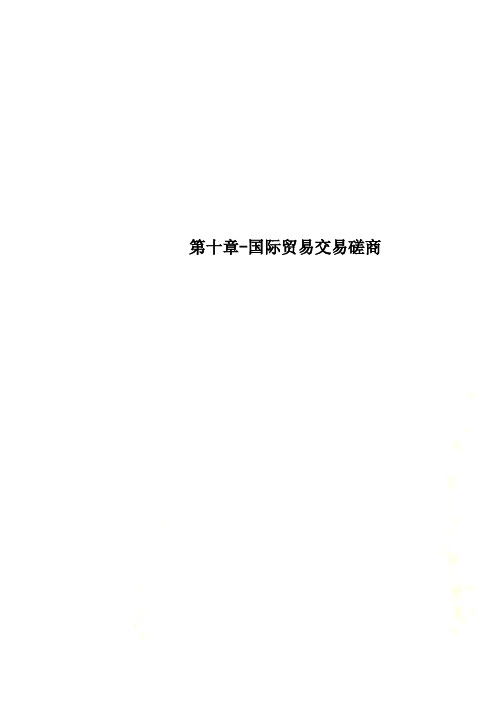
第十章-国际贸易交易磋商第十章进出口交易磋商教学目标:本章主要阐述了交易双方就交易条件进行磋商,以求达成一致协议的具体过程。
同时对合同的形式,内容,签订书面合同的意义,以及电子商务合同的法律效力等作了介绍。
教学重点:询盘,发盘,还盘,接受教学难点:发盘,还盘教学时间:8学时教学方式:讲练教学内容:第一节交易磋商一、交易磋商的内容:见书P280交易磋商的内容也即是合同条款中所包含的内容(一)主要交易条件(合同的主要条款)1、商品条件:货物的品名、数量、质量、包装2、价格条件:即货物的单价,总价,佣金和折扣3、交货条件:装运时间,地点,运输方式,运输保险等4、支付条件:支付工具和支付方式(二)一般交易条件一般有商品检验,索赔,不可抗力,仲裁,即合同的一般条款。
其中品名,品质,数量,包装,价格,装运,支付保险,商品检验,不可抗力,索赔,仲裁,前七项是必不可少的。
为主要交易条件,是进出口双方必须取得一致意见的内容。
至于其他条款,如不可抗力和仲裁,并非是合同不可缺少的部分,但为了防止和减少争议的发生和解决可能发生的争议,买卖双方在交易磋商时,也不能忽视。
同时在实际业务中,不是每次洽商都要对这些条款逐一商讨,因为普通商品交易一般都是使用固定格式的贸易合同,而条款中的商检,索赔。
不可抗力等通常都作为一般交易条件印在合同中,只要对方没有异议,就不必进行协商。
而且,许多老客户之间,双方在长期交易过程中已经形成一些习惯做法,也不需要在交易中就各项条款逐一协商。
这对加速磋商进程,节约费用开支都是有益的。
二、交易磋商的方式及选用(一)磋商方式进出口交易中,磋商方式主要有口头和书面两种。
口头磋商(是在谈判桌上面对面的谈判或者通过现代语音通信手段进行的交易磋商。
具体而言,可以是在各种交易会洽谈会或者展览会上的洽谈,也可以是代表团出访或者邀请国外客户来华洽谈等。
其优点是可以使双方及时,准确了解对方的合作态度,根据具体进展随时调整战略,但最大劣势在于成本相对较高。
国际贸易买卖合同的磋商 案例

国际贸易买卖合同的磋商案例一、合同双方。
甲方(卖方):[卖方公司名称],公司地址:[详细地址],联系人:[联系人姓名],联系电话:[电话号码]。
乙方(买方):[买方公司名称],公司地址:[详细地址],联系人:[联系人姓名],联系电话:[电话号码]。
二、货物详情。
1. 货物名称:[具体货物名称]。
这可是个超棒的东西呢,在市场上很受欢迎哦。
2. 货物规格:[详细规格说明]。
就像给这个货物画了一幅精准的画像,这样大家都清楚是什么样的啦。
3. 货物数量:[具体数量]。
这个数量可是我们经过认真商讨才确定的,不多不少,刚刚好满足需求。
三、价格条款。
1. 单价:[具体单价金额]。
这个价格可是我们讨价还价之后的甜蜜结果呢。
双方都觉得比较合理,毕竟大家都要赚钱,也要互相照顾啦。
2. 总价:[根据单价和数量计算得出的总价]。
这可是个很重要的数字,代表着这次交易的总价值哦。
四、交货条款。
1. 交货地点:[具体交货地点]。
这是我们商量好的地方,就像一个约定的小据点,货物会在这儿交接。
2. 交货时间:[具体交货日期]。
这个时间很关键呢,就像一场约会,货物要按时到达这个地点。
如果有特殊情况不能按时交货,那可得提前通知对方哦。
要是卖方不能按时交货,那可就像约会迟到一样不礼貌啦,要承担一定的责任呢。
如果是买方的原因导致不能按时收货,那也得负责哦。
五、包装条款。
货物的包装要采用[具体包装方式]。
这就像给货物穿上一件合适的衣服,既能保护货物在运输过程中不受到损坏,又能让货物看起来很整洁漂亮。
可不能马虎对待包装呀,要是包装不好,货物受伤了可就不好啦。
六、运输条款。
1. 运输方式:[具体运输方式,如海运、空运等]。
这是根据货物的特点、交货时间和成本等多方面因素考虑的呢。
就像选择出行的交通工具一样,要选最适合的。
七、付款条款。
1. 付款方式:[具体付款方式,如电汇、信用证等]。
这是保障双方权益的重要环节呢。
就像一个安全的交易桥梁,让双方都能放心。
第九章--国际货物买卖合同的磋商和订立PPT课件

24
25
电传四
10月14日上海机械进出口公司去电(还盘) YOURS TWELFTH LOWEST USD140 SUBJECT REPLY EIGHTEENTH HERE
你12日电传最低价140美元限18日复到
25
26
电传五
10月16日巴基斯坦某进口商来电(接受) YOUR FOURTEENTH WE ACCEPT 你14日电传我接受
9
第二节 发价和接受
10
一、发价
《《公公约约》》第第1十4四条条对(“2发)盘:”非定向义一:个或一个以 上 价建“特,议向定除,的 非一如人 提个果提 出或十出 建一分的 议个确建的以定议人上,,明的仅确并特应地且定视表表人为示明提邀相发出请 反盘订做 的人出 意立在发 向合得同到的接 受时,承受约束的意旨,即构成发盘”。
(一)构成发盘的四个条件:
1、
发盘必须表明订约意旨(无保留和限制);
2、发盘人必须向特定人提出;
3、发
盘的内容必须确定;
4、发盘必须送达受盘人; 10
1、发盘必须表明订约意旨 11
所谓“承受约束”是指发盘人于得到 受盘人对该发盘接受时,承担按发盘条件 与受盘人定立合同的责任。表明“承受约 束”的旨意可以是明示和默示两种: 明示:offer、firm offer、quote、book、
12
13
发盘内容完整性问题
在某些《情公况约下》第发5盘5条可:以如省果略合某同些已主有要效交订立易,条但件: (1明)示、或在暗双示方地“规一定般价格的或交规易定条如件何”确(定g价e格neral t(er2m, 事 关)在 人 贸s、a没 应 易引n有 视 的d用任 为 类c先o何为似n前相情已d的反况默iti往的下示on表销地来s示售引的)的的用函的情通订电协况常立或议下 价合先中, 格同前已双时。的定方在合订当有同明。 的某 些条件。 (3)、买卖双方在以前的业务交往中已形成 的习 惯做法。 (4)、“敞开价格条件”
- 1、下载文档前请自行甄别文档内容的完整性,平台不提供额外的编辑、内容补充、找答案等附加服务。
- 2、"仅部分预览"的文档,不可在线预览部分如存在完整性等问题,可反馈申请退款(可完整预览的文档不适用该条件!)。
- 3、如文档侵犯您的权益,请联系客服反馈,我们会尽快为您处理(人工客服工作时间:9:00-18:30)。
《国际贸易理论与实务》
第十三章国际货物贸易交易磋商的流程
教案
1、组织教学(1分钟)
2、复习回顾,创设情境(4分钟)
(1)复习导入
交易前的准备工作
如何寻找和选择交易对象
(2)请两组学生(分别代表买卖双方)上讲台表演购物情景剧(重点讨价还价)
学生思考:
问题1、情景剧的交易过程包含哪几个环节
(问价—讨价还价—成交)
问题2、国内一般交易包括这几个环节,进出口交易磋商的程
序是不是也包括这几个环节呢
——引出本课的课题:
国际货物贸易交易磋商的流程
5、案例巩固:
你好, 求购塑料餐垫,(附图仅参考形状),材质:塑料,可以是PP(厚度大概左右的),尺寸:45X35厘米,数量:分别按照3万,4万和5万报价,LOGO:单面满版彩色印刷,包装:单片/塑料袋,材质要环保(即适合食品接触安全),货期:若本周内确认订单,最快货期需要几天价格可以是出厂价格或是美金价格或是含税含运费价格,主要看贵司更倾向于哪种报价方式,麻烦请贵司根据以上信息确认最好价格,样品时间和交货期,同时建议并注明产品的尺寸,材质,图片参考以及其包装(装箱:箱规,毛净重)信息资料,并提供相同或类似款式产品图片参看.谢谢!
6、总结:
询盘的作用主要是引起对方的注意,诱发对方发盘。
询盘的对象要有选择,其多少要根据商品和交易的特点来确定。
对外询盘,既不宜只局限于个别客户而无法进行对比,也不宜在同一个地方多询盘,影响市场价格。
询盘是交易的起点,只是一种愿望表达,请将来可能的交易对象向自己发盘。
所列内容多是探询和参考性质的,没有购买或售出的义务,对双方都没有约束力,不是交易磋商的必经步骤。
二、发盘(Offer)(13分钟)
1、理解构成发盘的必要条件
(1)向一个或一个以上的特定人提出。
不指定受盘人的发盘,仅应视为发盘邀请。
(2)发盘的内容必须十分确定
主要指发盘所列条件是完整的、明确的和终局的。
完整的,是指准确阐明各项主要交易条件(品名规格、
数量、包装、价格、装运、付款、保险等七大要件)
明确的,是指交易条件清楚、具体、不含糊,没有“大
三、
通
晓
理
论
综
合
运
用(10分钟)一、综合训练题1
深化
练习
三、通
晓理论综合运用综合训练题2
询盘——发盘——还盘——接受
深化
练习
三、通晓理论综合运用深化练习
四、边做边学重在应用
(6)填写完毕后,点"发送"。
7 进口商登录后,收取出口商发盘的邮件。
双方经多次还
盘,最后进口商表示接受对方发盘。
填写邮件内容如下:
收件人:回复状态自动填写
主题:回复状态自动填写
合同号:(此时未建立合同,不需填合同号)
内容栏:
填写完毕后,点"发送"。
8 出口商收取进口商接受发盘的邮件;
教师
点评。
